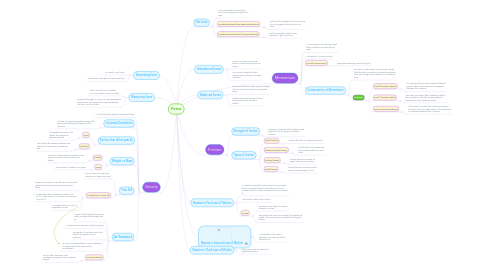
1. Describing force
1.1. Is a push or pull force
1.2. Described as strength in a given direction
2. Measuring force
2.1. The SI unit of force is Newton (N), names after Sir Isaac Newton
2.2. Direction/strength of a force can be represented by an arrow. The longer the arrow, the greater the force, and vice versa.
3. Gravity
3.1. A force that pulls objects toward eachother
3.2. Universal Gravitation
3.2.1. The law of universal gravitation states that gravity acts between all objects in the universe
3.3. Factors that affect gravity
3.3.1. Mass
3.3.1.1. The greater the mass of an object, the greater its gravitational pull
3.3.2. Distance
3.3.2.1. The further the distance between two objects, the lesser the gravitational pull
3.4. Weight vs Mass
3.4.1. Weight
3.4.1.1. The force of gravity that is exerted on an object or person on the surface of a planet
3.4.2. Mass
3.4.2.1. The amount of matter in an object
3.5. Free Fall
3.5.1. Occurs when the only force acting on an object is gravity
3.5.2. Acceleration in Free fall
3.5.2.1. Objects accelerate in free fall because they the unbalanced force of gravity is acting upon them
3.5.2.2. Acceleration due to gravity on Earth is 9.8 m/s^2. That means in 2 seconds, its velocity is 19.6 m/s^2.
3.5.2.3. An objects falls at 9.8 m/s^2, regardless of mass
3.6. Air Resistance
3.6.1. A type of fluid friction that occurs when an object falls through the air
3.6.2. An upward force exerted on falling objects
3.6.3. The greater the surface area of an object, the greater the air resistance
3.6.4. In a vacuum, where there is no air resistance, all objects fall at the same rate of acceleration
3.6.5. Terminal velocity
3.6.5.1. Occurs when the force of air resistance is equivalent to an object's weight.
4. Net force
4.1. The combination of more than one force acting on an object at a time
4.2. Combining forces from opposite directions
4.2.1. Subtract the strength of the lower force from the greater force to get a net force.
4.3. Combining forces from the same direction
4.3.1. Add the strengths of the forces together to get a net force
5. Unbalanced forces
5.1. Forces are unbalanced when there is a net force acting on an object.
5.2. Can cause an object to start moving, stop moving, or change direction.
6. Balanced forces
6.1. Forces are balanced when equal strengths of force act on an object from opposite sides
6.2. Objects that have balanced forces acting upon them are not in motion
7. Friction
7.1. Strength of friction
7.1.1. Depends on how hard the surfaces push together and the types of surfaces involved
7.2. Types of friction
7.2.1. Static friction
7.2.1.1. Friction that acts on stationary objects
7.2.2. Sliding (Kinetic) friction
7.2.2.1. Friction that occurs when two solid surfaces slide over each other
7.2.3. Rolling friction
7.2.3.1. Friction that occurs when an object rolls across a surface
7.2.4. Fluid friction
7.2.4.1. Friction that occurs when a solid object moves through a fluid
8. Newton's First Law of Motion
8.1. An object at rest will remain at rest, and an object that is in constant motion, will continue to be in constant motion, unless an external force acts upon it.
8.2. Also known as the Law of Inertia
8.3. Inertia
8.3.1. Tendency of an object to resist a change in motion
8.3.2. The greater the mass of an object, the greater its inertia. Thus, more force is needed to change its motion.
9. Newton's Second Law of Motion
9.1. Acceleration of an object depends on it mass and force exerted on it
10. Newton's Third Law of Motion
10.1. Every action has an equal and opposite reaction
11. Momentum
11.1. A characteristic of a moving object that is related to its velocity and mass
11.2. Momentum = mass x velocity
11.3. Unit of measurement
11.3.1. Kilograms-meters per second (kg⋅m/s)
11.4. Conservation of Momentum
11.4.1. The law of conservation of momentum states that the total momentum of interacting objects does not change in the absence of an external force
11.4.2. Collisions
11.4.2.1. With 2 Moving Objects
11.4.2.1.1. If 2 objects with the same mass but different speed collide, the momentum is swapped between the 2 objects
11.4.2.2. With 1 Moving Object
11.4.2.2.1. If an object in motion hits a stationary object, the momentum from the moving object is transferred to the stationary object
11.4.2.3. With Connected Objects
11.4.2.3.1. If an object in motion hits a stationary object, and fuses into one single object, the momentum is conserved between the 2 objects
